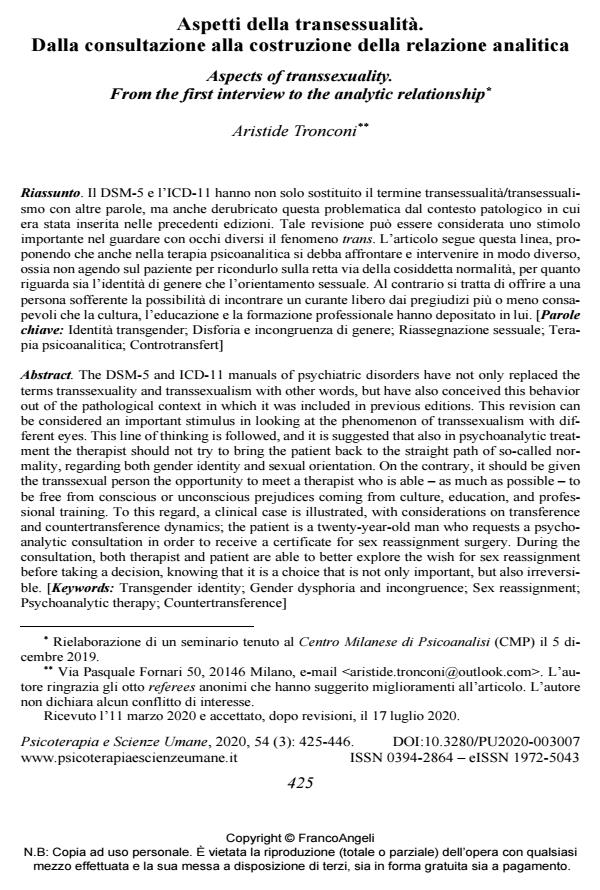Aspects of transsexuality. From the first interview to the analytic relationship
Journal title PSICOTERAPIA E SCIENZE UMANE
Author/s Aristide Tronconi
Publishing Year 2020 Issue 2020/3
Language Italian Pages 22 P. 425-446 File size 124 KB
DOI 10.3280/PU2020-003007
DOI is like a bar code for intellectual property: to have more infomation
click here
Below, you can see the article first page
If you want to buy this article in PDF format, you can do it, following the instructions to buy download credits

FrancoAngeli is member of Publishers International Linking Association, Inc (PILA), a not-for-profit association which run the CrossRef service enabling links to and from online scholarly content.
The DSM-5 and ICD-11 manuals of psychiatric disorders have not only replaced the terms transsexuality and transsexualism with other words, but have also conceived this behavior out of the pathological context in which it was included in previous editions. This revision can be considered an important stimulus in looking at the phenomenon of transsexualism with different eyes. This line of thinking is followed, and it is suggested that also in psychoanalytic treatment the therapist should not try to bring the patient back to the straight path of so-called normality, regarding both gender identity and sexual orientation. On the contrary, it should be given the transsexual person the opportunity to meet a therapist who is able - as much as possible - to be free from conscious or unconscious prejudices coming from culture, education, and professional training. To this regard, a clinical case is illustrated, with considerations on transference and countertransference dynamics; the patient is a twenty-year-old man who requests a psychoanalytic consultation in order to receive a certificate for sex reassignment surgery. During the consultation, both therapist and patient are able to better explore the wish for sex reassignment before taking a decision, knowing that it is a choice that is not only important, but also irreversible. Transgender identity; Gender dysphoria and incongruence; Sex reassignment; Psychoanalytic therapy; Countertransference
Keywords: Identità transgender; Disforia e incongruenza di genere; Riassegnazione sessuale; Terapia psicoanalitica; Controtransfert
Aristide Tronconi, Aspetti della transessualità. Dalla consultazione alla costruzione della relazione analitica in "PSICOTERAPIA E SCIENZE UMANE" 3/2020, pp 425-446, DOI: 10.3280/PU2020-003007